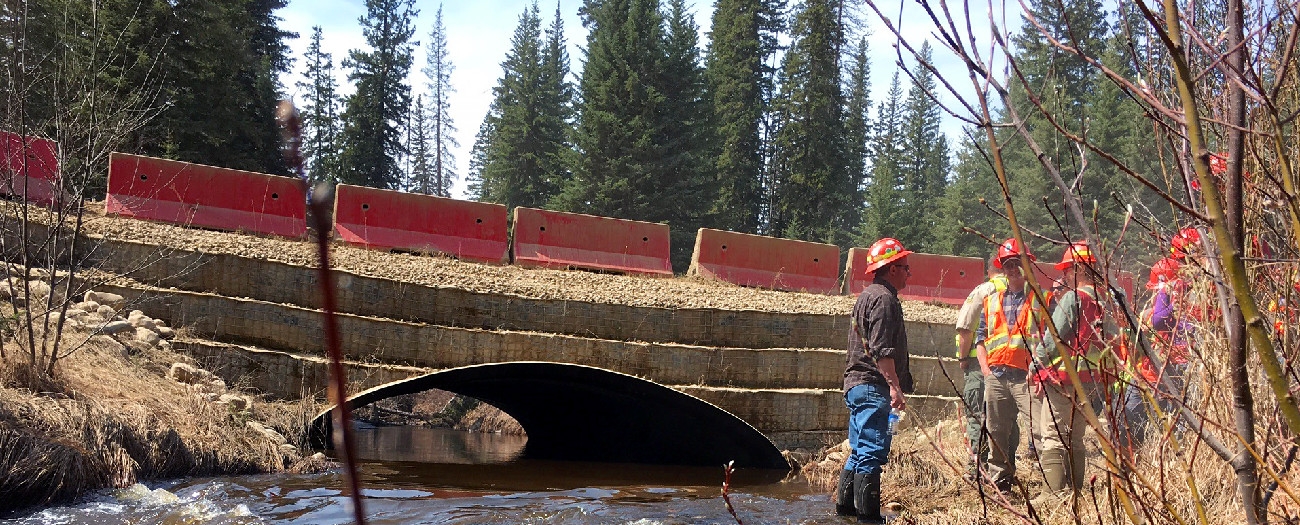How the AER is helping to protect fish species in Alberta’s foothills
Alberta - July 09, 2017Warm summer days bring smiles to the faces of fishermen eager to cast their flies and lures into Alberta’s many waterways. However, some fish species are being threatened because their habitat is fragmented by poorly constructed roadway water crossings, like bridges and culverts.
The AER, in partnership with Alberta Environment and Parks (Alberta Government), is co-leading an initiative called the Roadways Watercourse Crossings Remediation Directive to help protect fish populations that are being affected by inadequate roadway water crossings. Examples of fish species include the Athabasca Rainbow Trout, Bull Trout, and Westslope Cutthroat Trout.
With this collaborative approach, there could be no better news than to see fish numbers on the rise.
Jody Foster, AER water & fisheries technical specialist
“I’m pleased to be a part of this really great example of two regulators working together to solve a complex and historic problem. This initiative is strengthening relations between Environment and Parks and the Alberta Energy Regulator, moving us forward towards a shared goal of environmental stewardship,” says Todd Letwin, regional compliance manager with Alberta Environment and Parks.
Count Yourself In
Having a participation goal of 100 per cent is no small undertaking. Here are the companies under the two third-party service providers that are currently members:
Woodlands North
Canadian Natural Resources Limited
Foothills Stream Crossing Partnership (Recent recipient of an Emerald Award)
Apache Corporation
Cenovus Energy
Devon Energy
Repsol Canada
Seven Generations Energy Ltd.
Shell Canada
TAQA North Ltd.
Contact Jody Foster for more information on how your company can become a member.
Getting stuck in the mud
There are a number of factors at play. First, erosion and sedimentation at crossing locations can deposit fine materials in spawning areas and cover up fish eggs. Without being able to receive oxygen or get rid of waste, those eggs may die. Sediment also clogs fish gills, making it difficult or impossible for fish to breathe.
In addition, many culverts are undersized, which ultimately leaves fish unable to move upstream at these locations.
“Fish are genetically programmed to spawn in the same area each year. Cutting off access to their spawning grounds stops them from reproducing and could potentially lead to the loss of populations in that particular area,” explains Jody Foster, water & fisheries technical specialist with the AER, adding that thousands of fish could be lost each year at a single crossing.
There are tens of thousands of crossings throughout Alberta, many of which are owned by energy and forestry companies, private landowners, municipalities and counties, railway companies and farming operations. The goal of the initiative is to open up all impassable waterways and reconnect fragmented fish habitat.
“The goal is to have all crossing owners participate as members to ensure that 100 per cent of the crossings that affect fish passage are properly inspected, managed and/or remediated,” says Paul Harrington, an AER field inspector.
Working together to make a difference
Participating organizations work together to share best practices around training, monitoring, inspections, and remediation of crossings to ensure a consistent provincial standard. This standard is outlined in the Roadways Watercourse Crossing Manual and inspection form developed by various regulators, industry, and the Foothills Stream Crossing Partnership.
“There’s a big education component to our work. As part of the ongoing monitoring of energy operations, the AER conducts regular inspections of crossings,” says Foster. “When we issue noncompliances to companies, we educate them on the initiative and provide membership as an option for the crossing owners to build on the great foundational work that’s already been done.”
Looking forward, Foster is optimistic that they can get all owners involved in the remediation of roadway water crossings across the province and ultimately see fish numbers increase in areas where there’s been steady decline in recent decades.“With this collaborative approach, there could be no better news than to see fish numbers on the rise.”
Kate Bowering, Writer


